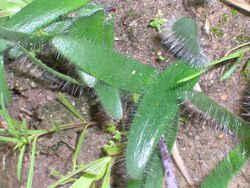Biology:Strumaria chaplinii
| Strumaria chaplinii | |
|---|---|

| |
| Leaves | |
| Scientific classification | |
| Kingdom: | Plantae |
| Clade: | Tracheophytes |
| Clade: | Angiosperms |
| Clade: | Monocots |
| Order: | Asparagales |
| Family: | Amaryllidaceae |
| Subfamily: | Amaryllidoideae |
| Genus: | Strumaria |
| Species: | S. chaplinii
|
| Binomial name | |
| Strumaria chaplinii (W.F.Barker) Snijman[2]
| |
| Synonyms[2] | |
| |
Strumaria chaplinii is a species of bulbous flowering plant in the family Amaryllidaceae, native to south-west Cape Provinces. It was first described in 1944 as Hessea chaplinii.[3]
Description
Strumaria chaplinii is a very small plant. The upper leaf surfaces are hairy. The flowers are star-shaped, with tepals that have flat faces, unlike similar species such as Strumaria discifera. Like other species of Strumaria, the flowers are borne in an umbel on long pedicels.[4]
Taxonomy
The species was first described as Hessea chaplinii in 1944 by Winsome Fanny Barker. It was transferred to Strumaria in 1994.[3]
Distribution and habitat
Strumaria chaplinii is native to the south-west Cape Provinces of South Africa.[2] It grows in moist pockets at the base of granite rocks in coastal fynbos.[1]
References
- ↑ 1.0 1.1 Snijman, D.A.; Victor, J.; Raimondo, D. (2014). "Strumaria chaplinii". The IUCN Red List of Threatened Species 2014: e.T63729364A63729367. doi:10.2305/IUCN.UK.2014-3.RLTS.T63729364A63729367.en. https://www.iucnredlist.org/species/63729364/63729367.
- ↑ 2.0 2.1 2.2 "Strumaria chaplinii (W.F.Barker) Snijman", Plants of the World Online (Royal Botanic Gardens, Kew), https://powo.science.kew.org/taxon/urn:lsid:ipni.org:names:978591-1, retrieved 2022-04-03
- ↑ 3.0 3.1 "Strumaria chaplinii (W.F.Barker) Snijman", The International Plant Names Index, http://www.ipni.org/ipni/idPlantNameSearch.do?id=978591-1, retrieved 2022-04-03
- ↑ Grossi, Alberto (2014), "Strumaria in cultivation", The Plantsman, (New Series) 13 (4): 222–225
Wikidata ☰ {{{from}}} entry
 |


